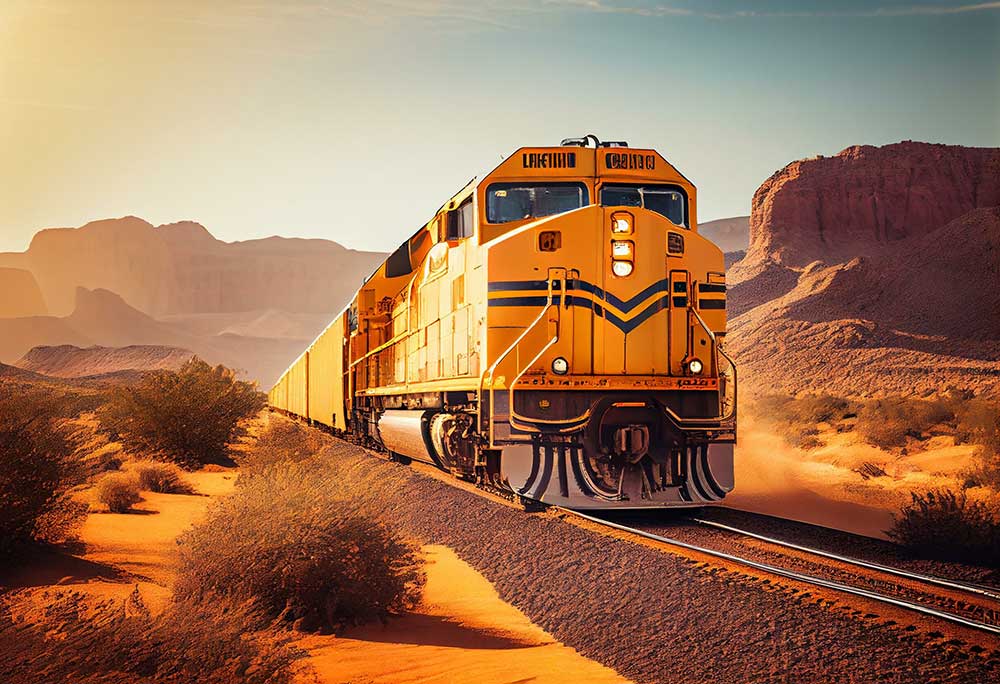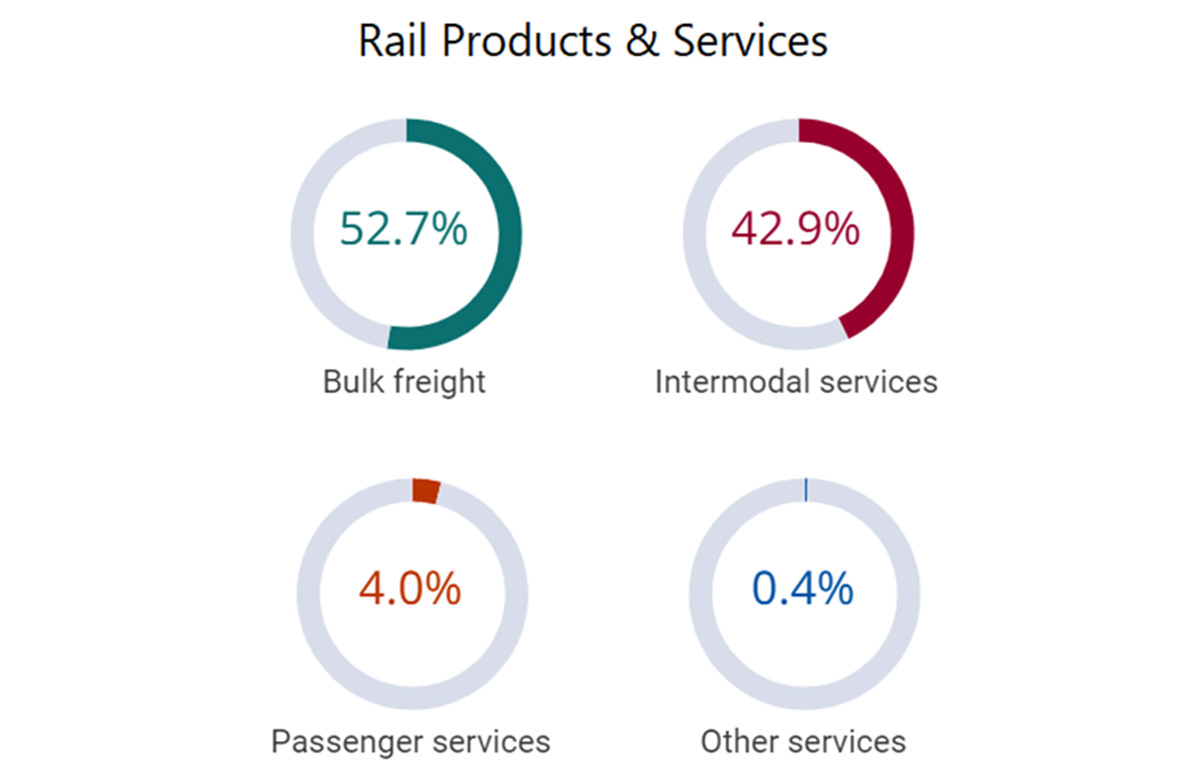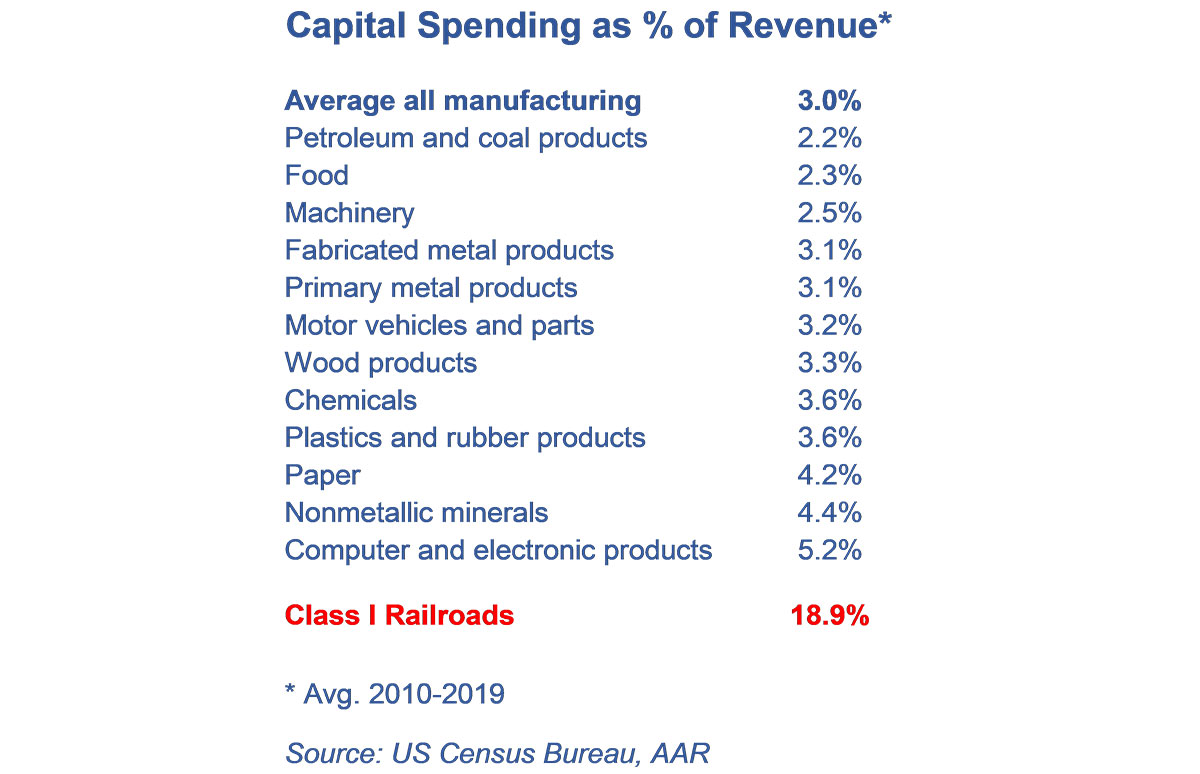- Navigator
- Expansion Solutions
- Industry Analytics and Strategy
- Transportation and Warehousing
 This article was originally published in the May/June 2023 issue of Expansion Solutions Magazine.
This article was originally published in the May/June 2023 issue of Expansion Solutions Magazine.
Looking at a map of the 140,000-mile-long US rail network you could imagine it as a nation-spanning circulatory system. Its tracks have the branching look of a land-based vascular organ, pumping passengers, and needed goods from within the central parts of the country and out to its extremities.
In 2022, the pace of this system started to resume its natural rhythm. Both freight (+7% Car Loads) and passenger (+134% Passenger Miles) rail services have seen substantial increases compared to 2020 as they recover from COVID-19-related shocks.
Freight rail service providers moved 12.1 million carloads of goods to market, and passenger rail providers moved 22.9 million passengers to their destinations around the country last year.
 Source: IBISWorld
Source: IBISWorld
The most well-known benefit of rail is the transportation services provided in the movement of goods. Freight rail contributed over 95% of the $113 billion in total rail transportation revenues in 2022. Passenger rail earns the remaining 4%. The largest share of long-distance freight (40% of ton miles) and nearly one-third of exports move by rail before leaving the US.
Reliable and cost-effective rail transportation leads to increased productivity, competitiveness, and growth for businesses that rely on it.
Strength in the Face of Adversity
The recent pandemic brought many changes and increased public awareness of the vital roles of our essential workers. It also highlighted many different essential functions of our economy that often operate unseen in people’s day-to-day lives.
Services like digital communication, basic utilities, and even the supply of clean water are all subconscious parts of modern living. Another critical ingredient for households and businesses is the vast transportation and logistics system that brings goods to be used either as intermediate factors of production or, increasingly for rail, as finished consumer goods.
During this recent period of uncertainty, when conducting business and procuring goods became even more complicated, the importance of the resiliency and efficiency of the US rail system became very clear.
Rail Investments Drive Economic Growth
Another way rail drives economic growth is as a development partner to the regions they operate in. The US rail network is large. It requires a significant financial investment in infrastructure within its host communities to operate — investments that, in turn, help spur economic growth.
 Rail transportation reinvests almost one in every five dollars of revenue, which is significantly higher than comparable industries (18% vs. 3%). The encouraging trend of increased profitability among Class 1 rail operators will be covered in more detail at the end of this article, but here it’s worth emphasizing the difficulty of maintaining efficiency with such capital-intensive operations. This past year is not an exception.
Rail transportation reinvests almost one in every five dollars of revenue, which is significantly higher than comparable industries (18% vs. 3%). The encouraging trend of increased profitability among Class 1 rail operators will be covered in more detail at the end of this article, but here it’s worth emphasizing the difficulty of maintaining efficiency with such capital-intensive operations. This past year is not an exception.
Freight rail invests tens of billions of dollars annually in streamlining logistics and operations and reducing bottlenecks in the busiest terminals. Savannah’s Mason Mega Rail project and Seattle/Tacoma Terminal 5 are recent examples on opposite sides of the country. Inland ports are receiving heavy investment as well. Projects from Cincinnati to Sioux City will expand the reach and efficiency of freight rail business segments while also creating new intermodal opportunities. Ventures that connect rail operations with containerized freight from other modes offer significant revenue opportunities.
Adapting to Change
A major change in freight rail operations has been the shift in consumer demand. In recent years, there has been a growing trend towards faster and more flexible delivery options, driven in part by the rise of e-commerce.
As a result, rail companies have had to adapt their operations to offer more expedited services, including same-day and next-day delivery options. The pandemic’s impact of accelerating the growth of e-commerce has created downstream ripples throughout the transportation and warehousing sectors.
Although pursuing intermodal activity is strategically necessary for many rail operators, it requires big changes. New cars that can efficiently carry containers are just the start. Building entirely new terminals, retrofitting existing terminals, expanding track and siding, and specialized transition facilities, gating systems, cranes, and other loading equipment are crucial ingredients to intermodal expansion. And that’s only the hardware.
All the preceding novelty also requires specialized staff and crews. Working across so many other modes of transportation requires more complicated business arrangements. Dispatching, signalization, safety protocols, scheduling, and tracking are all relied upon to realize the efficiency gains promised by intermodal transportation.
These developments have had a significant impact on the location, development, and usage of warehouses and other logistics and supply chain infrastructure. Multi-modal hubs and distribution centers allow for the efficient transfer of goods between transportation modes and can help reduce costs and increase the speed of delivery. This has, in turn, inspired companies to locate near intermodal facilities to take advantage of these benefits and has led to the development of new logistics hubs in locations that were previously not well-suited for freight transport or required other connecting modes.
Realizing Mutual Economic Goals Through Partnerships
All of this requires an enormous degree of regional collaboration and planning. The relationship between local economic development organizations (EDOs) and freight operators can be complex but is often characterized by cooperation. Many EDOs work closely with freight rail companies to promote economic development and job growth in their regions, leveraging the transportation infrastructure and services provided by rail to increase regional growth.
It’s not uncommon for EDOs and rail companies to align marketing and promotion efforts around business relocation and cluster development. EDOs often aid companies looking to locate or expand in their regions by providing information about transportation infrastructure and services available in the area. In turn, rail operators provide a high level of continuous investment and a long-term commitment to an area.
Freight rail companies can be a valuable resource for companies looking to transport goods and materials in and out of the region, and EDOs can work with rail companies to help identify sites that are well-suited for rail-dependent businesses.
EDOs may also work with freight rail companies to support infrastructure development, including the construction of new rail lines, intermodal facilities, and other logistics and supply chain infrastructure. Increasingly these partnerships involve multiple private and public organizations.
Federal Funding Programs Investing in Rail
Several federal funding programs heavily target rail. These programs can broadly be summarized as those related specifically to transportation investment and others that support economic growth more generally whether through location-based funding or by targeting industries or situational policies.
The FAST (Fixing America’s Surface Transportation) Act is a comprehensive federal transportation funding program established in 2015 with $305 billion in available funding. With several years of implementation behind it, many FAST Act programs are finally delivering projects that improve both freight and passenger rail services. While passenger rail transportation makes up a modest share of the US rail business, it enjoys an outsized share of funding eligibility, which makes it an attractive partner for freight rail operators and other regional transportation partners.
The American Rescue Plan Act (ARPA) was signed into law in March 2021 and includes funding for transportation infrastructure such as rail. The legislation includes $30.5 billion for public transportation, which can include funding for rail transit projects, and $1.7 billion for Amtrak. While this program more directly targets passenger rail, Amtrak owns less than 1,000 miles of track, which means that most passenger rail operations occur on privately owned track. Funding provided to Amtrak or regional passenger rail authorities for operational improvements can easily slot into infrastructure investments that benefit both parties.
The Infrastructure Investment and Jobs Act (IIJA), which was signed into law in November 2021, includes $66 billion for passenger and freight rail improvements, including $22 billion for Amtrak and $24 billion for freight rail projects, such as improving rail corridors and intermodal facilities. The legislation also includes funding for the development of a new grant program specifically for rail intermodal projects, with $5 billion in funding available over five years.
It’s still early in the project selection process for these last two programs, but their focus on network capacity, reducing congestion, safety, and economic development make them a good fit for meeting some of the intermodal needs outlined above. Beyond this, the legislation targets funding for specific projects, including the Alameda Corridor-East Construction Authority project in California and the CREATE program in Chicago. These shovel-ready projects are expected to receive a total of $5 billion in funding.
A developing theme from these and other recent legislation is the growing importance of onshoring strategic manufacturing industries in the face of mounting geopolitical uncertainty. The Creating Helpful Incentives to Produce Semiconductors (CHIPS) for America Act is a well-known example of this and is likely to spur industrial growth and increased demand for freight rail.
Environmental Sustainability Efforts Growing
As concerns around climate change continue to grow, freight rail is increasingly making sustainability a top priority. This includes efforts to reduce emissions, increase the use of renewable energy sources, and improve the efficiency of its operations through better route planning and more efficient use of resources.
By focusing on these key areas of innovation, efficiency, and sustainability, the industry can remain competitive and relevant in the 21st century, while also contributing to a more sustainable and environmentally responsible future.
Rail companies have also recognized the importance of reducing their carbon footprint and have taken steps to make their operations greener. Greenhouse gas emissions are directly related to fuel consumption.
According to US Environmental Protection Agency (EPA) data, freight railroads account for just 0.5% of total US greenhouse gas emissions and just 1.9% of transportation-related greenhouse gas emissions.
Association of American Railroads (AAR) analysis of federal data finds that moving more freight by rail instead of by road would help with goals to lower emissions.
Progress on climate goals is another area where passenger rail developments are positioned to make a big impact. Compared to freight rail, passenger rail is undersized and underfunded. Problems with expanding passenger rail service are often more complicated than freight expansion projects, but, if successful, the benefits in reduced emissions are enormous.
There are a limited number of geographic markets where passenger rail can thrive, however, and they tend to be the largest, densest, and wealthiest regions in the country. This means that small improvements in passenger rail service and access can have outsized benefits.
Another key feature of passenger rail improvements is the second-order effects of land use changes related to service expansion. By creating better connectivity in urban settings, rail service acts as a push on a virtuous cycle of increased real estate investment, business location, and migration that reduces vehicular traffic, grows the economy, and increases the value of the transportation asset.
The Challenges Ahead for Rail
The strategic landscape for rail transportation in the short term is, unfortunately, ripe with challenges. More than most businesses, freight rail’s demand levels are tightly coupled with the overall performance of the US economy. Stubbornly high interest rates and warnings of recession will threaten near-term growth. Another drag on freight rail growth is the continued de-emphasis on coal, which makes up a considerable portion of the bulk freight segment.
The high-profile freight train derailment in Ohio earlier this year has also brought attention to the safety improvements that could have prevented this particular incident, which is understandable.
But safe operations have always been a component of the (sizeable and regular) capital investments made by the rail industry. And these investments are working: Accident rates per railcar mile have been declining continuously for two decades with little fanfare.
Now, with the attention of the public and the US Congress on freight rail safety since the crash in Ohio, rail operators of every stripe will need to find more time and money to improve and promote their safety bona fides.
Labor needs are critical to expanding intermodal transportation service, but freight rail workforce issues run deeper than this. The Federal Railroad Administration’s recent investigation shows a labor force that is small and shrinking, aging, and increasingly undertrained for a rapidly evolving industry. Finally, while intermodal service may be the future for freight rail, immediate metrics show a mixed bag where the growth in this market has been absorbed mostly by trucks and air freight providers.
These challenges are diverse but none of them foreclose on a prosperous future for rail. The odd pairing of profitability without growth indicates an industry in transition.
Perhaps the biggest challenge for freight rail is the changing operational paradigm toward the fast and flexible provision of service. Many of the moves the industry needs to make to meet the business threats of the 21st century are already being executed. This foresight combined with ample federal funding and a returning US industrial base should allow rail transportation to continue to thrive.





